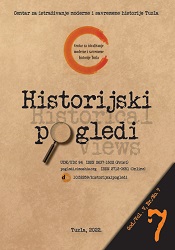Obnova i izgradnja vjerskih objekata na području općine Kalesija u periodu od 1964. do 1966. godine
Renovation and Construction of Religious Facilities on the Territory of Kalesija Municipality from 1964 to 1966
Author(s): Šefko SulejmanovićSubject(s): Political history, Government/Political systems, Politics and religion, Post-War period (1950 - 1989), History of Communism
Published by: Centar za istraživanje moderne i savremene historije Tuzla
Keywords: Religious buildings; rehabilitation and reconstruction; Islamic Religious Community; Commission for Religious Affairs; Municipal Assembly of Kalesija; Assembly of Tuzla District;
Summary/Abstract: The Second World War, along with great human sacrifices and material destruction, also brought radical changes in the socio-political system in the new (AVNOJ) Yugoslavia. Immediately after the end of the Second World War, the state's attitude towards religious communities was highly suspicious. However, in addition to the need to renovate private and social infrastructure, religious communities have also launched initiatives to rehabilitate and rebuild war-torn and/or damaged religious buildings. Until the 1960s, the requests of religious communities far the renovation of their buildings were treated with suspicion by the competent stale authorities, and were generally resolved unfavorably. The Communist Party, which authoritarianly controlled and directed all social flows, did not look favorably on such and similar activities of religious communities. Procedures for the restoration of religious buildings were complex and strictly controlled. In each municipality there were Religious Affairs Commissions that closely monitored the behavior of individua/s, believers and clergy, as well as religious bodies and institutions in their area. For more complex issues, the municipal commissions were supervised by the district commissions for religious affairs, to whom they very often turned for their opinion and/or consent. On rare occasions, when even the district commissions did not have a secure position on an issue, they turned to the republic commissions. Therefore, it is not surprising that the procedures were often lengthy, which means that they waited for several months to resolve the submitted requests, and sometimes even a year or more. Not only the Islamic community, but also Bosniaks as a nation faced great organizational and even existential difficulties. While their positive role and nationality was recognized in the war, immediately after the end of World War II and the establishment of AVNOJ Yugoslavia, Muslims/Bosniaks were both de facto and de jure challenged as a people. There was no place for them in the official stale coat of arms, which had five, instead of six torches, which symbolized the peoples of the Federal People 's Republic of Yugoslavia. It was not until 1963 that the Communist Party began to revise its manipulative attitudes towards Muslims/Bosniaks, thus beginning the process of recognizing them as a separate people. Since then, they have begun to declare themselves as Muslims, with a capital letter "M". Although this act did not fully satisfy the constitutional rights of Muslims/Bosniaks, this was a big step towards their national affirmation. The central focus of this paper is the monitoring and analysis of procedures for the rehabilitation and restoration of religious buildings of the Islamic (religious) community in the municipality of Kalesija in the mid-1960s. The paper includes three requests for the construction and renovation of religious buildings. In chronological terms, the request for the renovation of the existing mosque in the village of Kalesija, which was dilapidated and unconditional for use, was first analyzed. The next request refers to the construction of a mosque in the village of Golčin instead of the demolished old mosque with a wooden minaret. The third request to the Commission for Religious Affairs of the Municipal Assembly of Kalesija was sent by the residents of the village of Mahmutovići. The paper primarily relies on thirteen original documents deposited in the Archives of Tuzla Canton that thematize the rehabilitation, restoration and construction of religious buildings and at the same time authentically depict the current socio-political situation and citizens ' rights to religion and practical application of these rights. In addition to the original documents, the paper uses relevant literature on social processes in Yugoslav society from the end of World War II to the late 1960s, with special emphasis on the position of Muslims/Bosniaks at the time of imposing collective lobotomy and denying Bosniak names and identities.
Journal: HISTORIJSKI POGLEDI
- Issue Year: V/2022
- Issue No: 7
- Page Range: 270-291
- Page Count: 22
- Language: Bosnian

